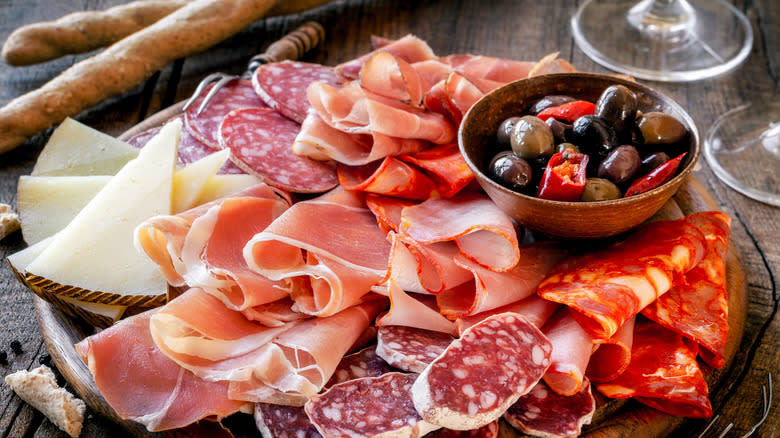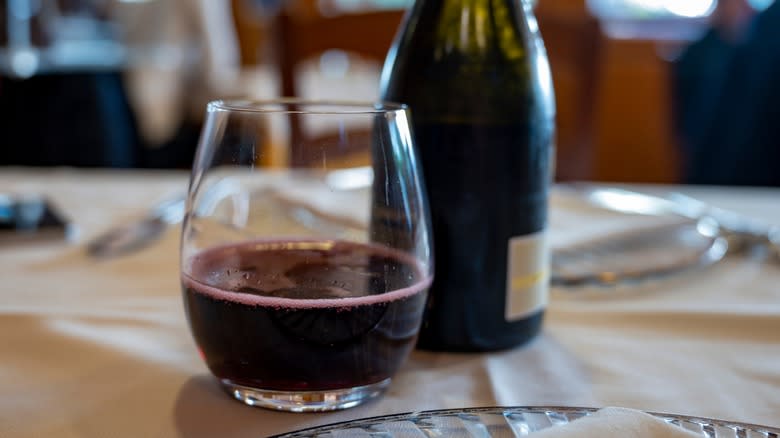The Cured Meats That Are Hardest To Pair With Wine, According To An Expert

Wine and food are great separately, but paired together, they can be sublime. Think of a perfectly flash-cooked ribeye steak followed by a sip of cabernet sauvignon, or the dried currant and spice of a ruby port paired with a bite of the highest-ranked dark chocolate out there. Sometimes, though, these pairings become rather challenging, as is the case with spicy cured meats — one of the hardest foods to properly pair with wine. We spoke with Scott Mattson, co-owner and sommelier of Denver's jazz and supper club Nocturne, about solving this very problem, and he didn't disappoint.
"Speck can be astringent and tricky with still wines. It's best with Lambrusco!" Mattson told The Daily Meal. "Genoa Salami or Salumi Calabrese can get pretty spicy, so avoid wines that are dry and high in alcohol ... again, reach for the Lambrusco." Clearly, it's time to get to know Lambrusco a little better, for many reasons: It's delicious, refreshing, full of personality, and always reasonably priced.
Read more: The 13 Best Steaks For Grilling
Lambrusco Is A Breed All Its Own

Lambrusco is a perfect sweet wine for beginners. It's lively and spritzy — the kind of wine referred to as "frizzante," or lightly sparkling, as opposed to "spumante," which connotes a full-on bubbly like Champagne. (This also means its alcohol content is often lower than its sparkling counterparts: Lambrusco can have an ABV as low as 8%, making it an ideal pairing for spicy foods.) This wine is also made from an ancient grape; Classical-era writers like Virgil and Pliny the Elder mention a wild vine growing in the countryside of Italy's Po Valley region which they called "Lambrusca vitis." These days, there are over 60 sub-varieties of the grape being made into wine in four different DOCs (or denominazione di origine controllata, which translates to "designation of controlled origin"), mostly based in the Emilia-Romagna region.
Why would a glass of Lambrusco pair well with spicy cured meats? For starters, it's refreshing: Sparkling and served slightly chilled, it will brighten and cleanse the palate of the meats' brine and oil. Lambruscos, which range in color from rosé to inky red, tend to have an earthy taste and assertive acidity that perfectly balance savory and salty flavors. And that's just a generalization — if you want to go in-depth on meat-Lambrusco pairings, you have to get specific.
One Lambrusco Grape Is Already Named After Salami

For under $20, you can grab a bottle of Lambrusco Salamino di Santa Croce, so called because its cylindrical grape clusters resemble cured sausages. These wines can be off-dry (and as we all know, sweetness is a great match for spice), with notes of dark fruit and dried cherry. Most folks agree that this specific Lambrusco is a great wine to pair with pizza.
In our interview with Scott Mattson, he mentioned speck, the smoked Italian ham cured with spices like juniper and bay. A potentially great pairing for this meat is a Lambrusco di Sorbara, a rosé-colored wine that not only goes hand-in-hand with spice but boasts delicate fruity and floral aromas of watermelon, violets, and orange blossoms. Together, these make an utterly elegant nosh that's easy on the wallet, as most bottles of this Lambrusco will only set you back about $10. And if you'll recall, most Lambrusco originates from Emilia-Romagna, as do Prosciutto and Parmesan Reggiano cheese, so consider this the official start of charcuterie season.
Read the original article on Daily Meal.

